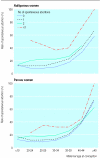Maternal age and fetal loss: population based register linkage study
- PMID: 10864550
- PMCID: PMC27416
- DOI: 10.1136/bmj.320.7251.1708
Maternal age and fetal loss: population based register linkage study
Abstract
Objective: To estimate the association between maternal age and fetal death (spontaneous abortion, ectopic pregnancy, stillbirth), taking into account a woman's reproductive history.
Design: Prospective register linkage study.
Subjects: All women with a reproductive outcome (live birth, stillbirth, spontaneous abortion leading to admission to hospital, induced abortion, ectopic pregnancy, or hydatidiform mole) in Denmark from 1978 to 1992; a total of 634 272 women and 1 221 546 pregnancy outcomes.
Main outcome measures: Age related risk of fetal loss, ectopic pregnancy, and stillbirth, and age related risk of spontaneous abortion stratified according to parity and previous spontaneous abortions.
Results: Overall, 13.5% of the pregnancies intended to be carried to term ended with fetal loss. At age 42 years, more than half of such pregnancies resulted in fetal loss. The risk of a spontaneous abortion was 8.9% in women aged 20-24 years and 74.7% in those aged 45 years or more. High maternal age was a significant risk factor for spontaneous abortion irrespective of the number of previous miscarriages, parity, or calendar period. The risk of an ectopic pregnancy and stillbirth also increased with increasing maternal age.
Conclusions: Fetal loss is high in women in their late 30s or older, irrespective of reproductive history. This should be taken into consideration in pregnancy planning and counselling.
Figures





Comment in
- ACP J Club. 2001 Jan-Feb;134(1):33
-
The risks of having children in later life. Social advantage may make up for biological disadvantage.BMJ. 2000 Jun 24;320(7251):1681-2. doi: 10.1136/bmj.320.7251.1681. BMJ. 2000. PMID: 10864522 Free PMC article. No abstract available.
-
Maternal age and fetal loss. Missing abortion stratification adds to confusion.BMJ. 2001 Feb 17;322(7283):429-30. doi: 10.1136/bmj.322.7283.429. BMJ. 2001. PMID: 11179146 Free PMC article. No abstract available.
-
Maternal age and fetal loss. Having an induced abortion increases risk in future pregnancies.BMJ. 2001 Feb 17;322(7283):430. BMJ. 2001. PMID: 11179169 No abstract available.
-
Maternal age and fetal loss. Data should have been stratified for smoking habit.BMJ. 2001 Feb 17;322(7283):430. BMJ. 2001. PMID: 11179170 No abstract available.
-
Maternal age and fetal loss. Older women have increased risk of unexplained fetal deaths.BMJ. 2001 Feb 17;322(7283):430. BMJ. 2001. PMID: 11179171 No abstract available.
-
Maternal age and fetal loss. Risks of having children in later life need to be explained.BMJ. 2001 Feb 17;322(7283):430. BMJ. 2001. PMID: 11179173 No abstract available.
References
-
- Fretts RC, Schmittdiel J, McLean FH, Usher RH, Goldman MB. Increased maternal age and the risk of foetal death. N Engl J Med. 1995;333:953–957. - PubMed
-
- Petitti DB. The epidemiology of foetal death. Clin Obstet Gynecol. 1987;30:253–258. - PubMed
-
- Berkowitz GS, Skovron ML, Lapinski PH, Berkowitz RL. Delayed childbearing and the outcome of pregnancy. N Engl J Med. 1990;322:659–664. - PubMed
-
- Harlap S, Shiono PH, Ramcharan S. A life table of spontaneous abortions and the effect of age, parity and other variables. In: Porter IH, Hook EB, editors. Human embryonic and foetal death. New York: Academic Press; 1980.
-
- Risch HA, Weiss NS, Clarke AE, Miller AB. Risk factors for spontaneous abortion and its recurrence. Am J Epidemiol. 1988;128:420–430. - PubMed
Publication types
MeSH terms
LinkOut - more resources
Full Text Sources
Other Literature Sources
Medical
